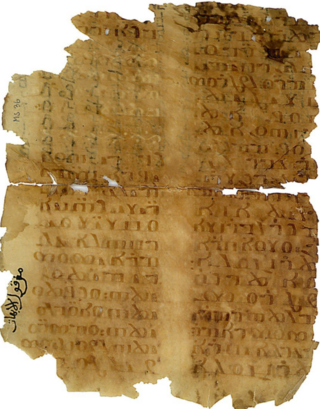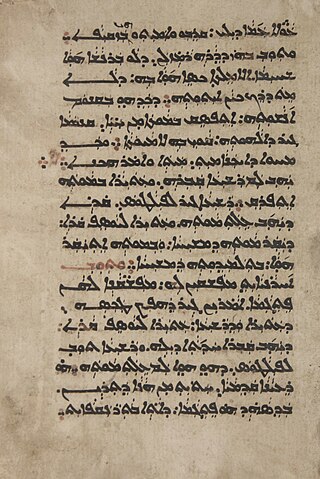Related Research Articles
Athanasius II Baldoyo, also known as Athanasius of Balad, and Athanasius of Nisibis, was the Patriarch of Antioch and head of the Syriac Orthodox Church from 684 until his death in 687.
Narsai was one of the foremost of Assyrian poet-theologians, perhaps equal in stature to Jacob of Serugh, both second only to Ephrem the Syrian.

Christian Palestinian Aramaic was a Western Aramaic dialect used by the Melkite Christian community, probably of Jewish descent, in Palestine, Transjordan and Sinai between the fifth and thirteenth centuries. It is preserved in inscriptions, manuscripts and amulets. All the medieval Western Aramaic dialects are defined by religious community. CPA is closely related to its counterparts, Jewish Palestinian Aramaic (JPA) and Samaritan Aramaic (SA). CPA shows a specific vocabulary that is often not paralleled in the adjacent Western Aramaic dialects.
Moses bar Kepha or Moses bar Cephas was a writer and one of the most celebrated bishops of the Syriac Orthodox Church of the ninth century.
The Syro-Hexaplar version is the Syrian Aramaic (Syriac) translation of the Greek of the Septuagint as found in the fifth column of Origen's Hexapla. The translation was made by Bishop Paul of Tella at the monastery of the Enaton in Egypt around 617.
British Library, Add MS 12150 is the second oldest extant Syriac manuscript and the oldest codex bearing a date in any language.

Gorgias Press is a US-based independent academic publisher specializing in the history and religion of the Middle East and the larger pre-modern world.
George Anton Kiraz is a Syriac scholar, best known for his contribution to modern Syriac studies.
Ahudemmeh was the Grand Metropolitan of the East in the Syriac Orthodox Church from 559 until his execution in 575. He was known as the Apostle of the Arabs, and is commemorated as a saint by the Syriac Orthodox Church.

Teseo Ambrogio degli Albonesi was an Italian humanist. During the Fifth Council of the Lateran, Teseo was tasked by Cardinal Bernardino López de Carvajal to give religious instruction to a Syrian priest in Latin and liturgy and became an expert in the Syriac language himself. He was a proponent of Christian Kabbalah and an early student of Semitic languages. His Introductio ad Chaldaicam linguam, Syriacam, atque Armenicam, et decem alias linguas was one of the earliest Western studies of Syriac and Armenian. The bulk of the work consists of an Introduction to Chaldean, Syriac and Armenian. To this is added an Appendix which includes the presentation of alphabets, including brief references to Coptic and Ethiopic and comments on the ancestry of European languages, especially languages of Italy, with a discussion of Etruscan.
Mosesof Nisibis was a West Syriac monk and scribe. He was the abbot of Dayr al-Suryan, the Syrian monastery in the Wadi al-Natrun in Egypt, from 914 at the latest. He brought together and helped preserve one of the most important collections of ancient Syriac manuscripts, which is still of critical importance to scholars today.
The Chronicle of Pseudo-Joshua the Stylite is an anonymous Syriac history of the period 494–506 AD. Its actual title as given in the manuscript is A Historical Narrative of the Period of Distress Which Occurred in Edessa, Amid and All Mesopotamia. It is divided between two distressful events that occurred in Edessa and the surrounding region: an outbreak of plague, locusts and famine from 494 to 502 and the Roman–Persian war of 502–506. It is the earliest surviving work of Syriac historiography and provides the most detailed account of the Roman–Persian war. It was written near in time to the events it describes and is thus of the highest historical value.
Cyrus of Edessa was a Syriac writer and teacher in the Church of the East. He was probably a native of Edessa. He studied at the school of Nisibis under Aba, the future patriarch, and then taught at the school of Seleucia-Ctesiphon, eventually rising to become its headmaster. He founded a monastery at Ḥirta sometime after the death of Aba (552).
Thomas of Edessa was a theologian of the Church of the East who wrote several works in Syriac, most of them lost.
George was the Syriac Orthodox bishop of the Arabs around Aleppo and the upper Euphrates from 686 or 687 until his death. A polymath steeped in ancient Greek philosophy, his writings are an important source for Syriac history and theology.
Joseph (Yawsep) Hūzāyā was a Nestorian teacher and author. His name indicates that he hailed from Khuzestan.
John, in Syriac Iwannis, was a Syriac Orthodox writer and the metropolitan bishop of Dara (Anastasiopolis). He wrote extensively on theology, philosophy and liturgy in the Syriac language.

Yoḥannan bar Zoʿbi, commonly Rabban Yoḥannan and sometimes anglicized John bar Zobi, was a monk, grammarian, philosopher, theologian and liturgist of the Church of the East who wrote in Syriac.
Barsauma was a Syriac-speaking monk and holy man, a leading opponent of the Council of Chalcedon of 451. He is the subject of a biography in Syriac composed about a century after his death. He is regarded as a saint by the Oriental Orthodox.
John of Apamea, John the Solitary, or John the Solitary of Apamea was a 5th-century Syriac Christian writer from Apamea, Syria.
References
- 1 2 "Timeline | Beth Mardutho".
- ↑ "About | Beth Mardutho".
- ↑ "Beth Mardutho Students at the Mor Aphrem Center – Syriac Orthodox Church of Antioch". syrianorthodoxchurch.org.
- ↑ "Digital Syriac Corpus". syriaccorpus.org.
- ↑ "Qoruyo | Beth Mardutho".
- ↑ "e-GEDSH". gedsh.bethmardutho.org.
- ↑ "Search Results | Theological Commons". commons.ptsem.edu.
- ↑ "Internet Archive". archive.org.
- ↑ "eBethArke: The Syriac Digital Library | Digital Collections". collections.libraries.rutgers.edu.
- ↑ Kiraz, George A. (2010-04-01). "Ebetharké: The Syriac Digital Library. First Report". Hugoye: Journal of Syriac Studies. 4 (1). Gorgias Press LLC: 269–272. doi: 10.31826/hug-2010-040118 . ISSN 1097-3702.
- ↑ Beard, Isaiah (2017-02-13). "The eBethArké Syriac digital library: a case study". Digital Library Perspectives. 33 (1). Emerald: 40–47. doi:10.1108/dlp-07-2016-0017. ISSN 2059-5816.